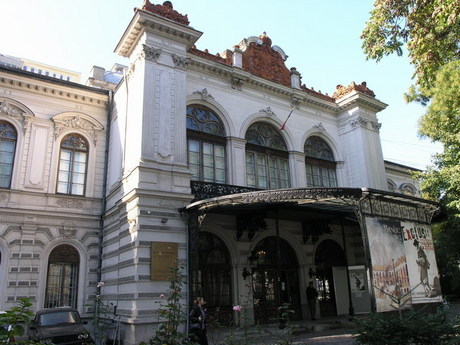Sutu Palace
Famous for the grandiose balls held here in the 1900s, Sutu Palace was built in neogothic style between 1832 and 1834 by foreign minister Costache Sutu, to designs of architects Johann Veit and Konrad Schwinck. In 1862, the palace was redecorated by sculptor Karl Storck, who created three arcades and a monumental stairway; a huge Murano mirror was added in the hallway. Only the painted ceilings, the stucco, the parquet flooring and the tile stoves have been preserved. Since 1959, the building has housed the Bucharest History & Art Museum. This is the right place if you want to escape the crowds in the city. Don't pass the Sutu Palace - visit it right after the flight to Romania.
The Great Costache Sutu, together with two Venetians architects had built the Sutu Palace in a neo-gothic style, which has encountered its true glamour in the beginning of the 19th century, due to the prestigious and luxuriant events held by the Sutu family. The building was well known in the last century for the balls and the dancing evenings organized in there. The pomp of Sutu Palace was otherwise admired and envied by Bucharest high society. The museum settled in 1921, contains over 400.000 historical objects that give relevance of the city memory - facts, events and personalities.
Sutu Palace enjoyed maximum brightness in the mid-nineteenth century, between luxury soirees organized by Gregory and wife Irene Sutu. At that time the palace was surrounded by gardens where there were peacocks, pheasants and other rare birds.
Inside the Sutu palace are found monumental solid wood doors, the crystal lamp which illuminates the pleasant and sober room, a grand staircase with two arms, crowned by a huge Murano glass mirror that wrongs the view which, amazed , thinks the hall is much larger.
The first hall of the palace from the floor recomposes the space of a salon specific to the Bucharest of the mid-nineteenth century, as it appears in documents. The furniture is upholstered in purple fabric with large white dots and appears smaller than that of today. The walls were sober brown and blue decorations and are painted in brick colour.
In the next room are exposed archaeological evidences attesting the age of human settlements within Bucharest. In many districts of Bucharest were found objects from the Neolithic, the Bronze Age and later in the Geto-Dacian.
The reception salon from the ground floor is the place where temporary exhibitions of painting or photography are held and sometimes concerts of chamber music, where public access is free.
Hall I
The profound ambient changes that took place in Bucharest, in the 19th c., concern not only the aspect of the town, but also the decoration and interior arrangements. The first hall of the museum reconstitutes a typical Bucharester drawing-room of the 19th c. according to the documents of the epoch. If, at the beginning of the century, the Oriental patterns were predominating, being defined by absence of big pieces of furniture, by divans with pillows and Oriental carpets, after 1830 the houses got an Occidental aspect. The most appreciated styles of furniture were Louis – Philippe and Napoleon III
personalities of the Sutu family are evoked: Costache, great seneschal, senator Grigore Suciu and his wife, Irina Sutu, daughter of the famous banker Hagi Moscu.
Hall II - Archeology
The archeological discoveries attest, on Bucharest area, traces of human presence dating from about 150,000 B.C., which makes the capital of Romania one of the oldest populated area of Europe
the settlements were situated on the banks of the two rivers that cross Bucharest – the Dambovita and Colentina. Situated in the middle of an area rich in forests and water, with a soil good for agriculture and animal breeding, the territory of Bucharest was dense enough inhabited, as the discoveries made by the museum archeologists show in sites as: Mogosoaia, Chitila, Bordei, Herastrau, Lacul Tei, Plumbuita, Fundenii Doamnei, Rosu-Militari, Mihai – Voda, a.s.o. The spectacular discoveries date from Neolithic – it is about household objects, or ritual pieces belonging to material cultures as Dudesti, Gumelnita, Boian. Bronze processing is attested by a multitude of objects: tools, weapons, accessories, discovered in different zones. The presence of the Dacians is proved by a series of settlements such as those from Mihai-Voda and Radu-Voda, Bucur’s Church, Lacul Tei, Pipera, Militari. Different treasures of Greek coins or local imitations, as those from Herastrau,Colentina, Pipera, Fundeni, Popesti-Leordeni, date from the Geto-Dacian time urme romane au fost scoase la iveala la Giulesti, Lacul Tei. Roman traces were discovered at Giulesti, Lacul Tei. Bronze cult statues – Apolo and Venus certify the presence of the Roman cults in Dacia.



